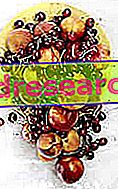Free radicals and antioxidant defenses
Antioxidants are substances that can neutralize free radicals and protect the body from their negative action. The anticancer properties of many foods are linked to their precious antioxidant content.
During the numerous metabolic processes a small quantity of oxygen gives rise to chemically very reactive molecules due to the presence in the outer orbital of one or more unpaired electrons. These molecules, called free radicals, are capable of damaging cellular structures such as the plasma membrane and DNA. The negative action of free radicals affects the health of the entire body:
- accelerating cellular aging processes
- depressing the immune system
- favoring the onset of numerous diseases and cancers
Our body is able to control the activity of free radicals through special endogenous (synthesized independently) and exogenous (present in food) antioxidant substances.

Non-enzymatic substances with antioxidant properties include Vitamin E, Vitamin C, carotenoids, polyphenols and anthocyanins.
While on the one hand many foods exert a protective action against free radicals, on the other hand incorrect eating habits can increase their activity (diet too rich in animal fats, excessive consumption of vegetable oils and fatty fish, excess iron, intolerances) food). The most dangerous foods by far are those rich in lipids and in particular polyunsaturated fatty acids (fish, vegetable oils, dried fruit). However, nature has been able to associate these nutrients with high amounts of vitamin E in order to neutralize, at least in part, the formation of free radicals. Precisely for this reason, a certain amount of vitamin E is artificially added to food supplements based on polyunsaturated fatty acids (we nevertheless recommend checking their presence before purchase).
Even exposure to atmospheric pollutants, ionizing or ultraviolet radiation, drug abuse, smoking and intense physical activity can dangerously increase the synthesis of free radicals.
By closely observing the skin of a person who is frequently exposed to the sun without protection, we can realize the harmful effect of these "waste products". Doing the same thing with a sportsman we would probably be impressed by his youthful appearance. If on the one hand physical activity increases the synthesis of free radicals (as happens in the case of prolonged exposure to sunlight), on the other hand training makes enzymatic antioxidant systems much more effective.

Anti-oxidant supplement Antiage X115 + Plus
New generation anti-aging supplement. Double Day & Night formulation with high concentration of assets; supports and optimizes antioxidant defenses and stimulates the synthesis of collagen, hyaluronic acid and elastin . " More information "
Once again the combination of correct nutrition and physical activity is confirmed as the best weapon to combat aging and illnesses linked to well-being.
Antioxidants in food
Many foods, especially those of plant origin, contain hundreds of substances with more or less marked antioxidant activity. Among the best known are polyphenols and some vitamins (A, C and E). To try to quantify the antioxidant power of foods, the American Department of Agriculture has developed an ORAC scale, based on the capacity of absorbing radical oxygen.
Five portions a day of fruit and vegetables bring about 5000 ORAC units, a quantity more than enough to protect themselves from free radicals.
The most antioxidant-rich foods according to the ORAC scale are:
Juice from black grapes 1 glass = 5216 units
Blueberries 1 cup = 3480 units
Cooked green cabbage 1 cup = 2048 units
Spinach cooked 1 cup = 2042 units
Beetroot cooked 1 cup = 1782 units
More 1 cup = 1466 units
Black plums 3 = 1454 units
Brussels sprouts cooked 1 cup = 1384 units
Grapefruit juice 1 glass = 1274 units
Pink grapefruit 1 = 1188 units
Strawberries a cup = 1170 units
Orange juice 1 glass = 1142 units
Orange 1 = 983 units
Susina 1 = 626 units
Roast potato 1 = 575 units
Avocado 1 = 571 units
Black grape a bunch = 569 units
Pepper 1 = 529 units
Kiwi 1 = 458 units
American potato 1 = 433 units
One cup cooked green beans = 404 units
One cup cooked cauliflower = 400 units
Black raisins 1 tablespoon = 396 units
Cipolla 1 = 360 units
White grapes 1 bunch = 357 units
Aubergine 1 = 326 units
Apple 1 = 301 units
Fishing 1 = 248 units
Banana 1 = 223 units
Pear 1 = 222 units
Melon three slices = 197 units
Raw spinach 1 plate = 182 units
Apricots 3 = 172 units
Tomatoes 1 = 116 units
Cucumbers 1 = 36 units
Antioxidant smoothie
X Problems with video playback? Reload from YouTube Go to Video Page Go to Video Recipes Section Watch the video on youtubeAntioxidant nutrients can be taken with different natural foods without the need for supplements. In particular situations (incorrect diet, intense physical activity), external integration can be useful. However, it is not yet clear whether the protective action derives from the individual antioxidant substances or from the way in which nature has been able to combine them in various foods. What seems certain now is that:
25% of cases of colorectal cancer, 15% of breast cancer and 10% of prostate cancer, pancreas and endometrium could be avoided by adhering to the indications of the Mediterranean diet [ Trichopoulou et al, 2000 ].
To top up antioxidants, experts recommend eating at least five portions of fruit and vegetables every day. To combat the production of free radicals it is good to limit the total caloric intake and the consumption of fats, salt, fries, cured meats and grilled meats.



